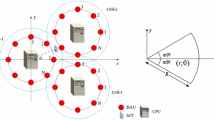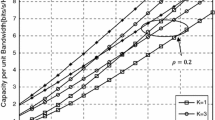Abstract
Based on maximum desired signal criterion, a novel single selection transmission scheme (SSTS) is proposed. In this case, the bit error rate (BER) of downlink distributed antenna systems in multicell environment is investigated. In particular, non-central limit theorem is adopted for SSTS to embody the effect of short-term fading on interference, where the variance of interference plus noise is considered as random variable with changeable variance influenced by the short-term fading. It is assumed that the channels suffer from independent identical Rayleigh fading together with propagation pathloss, and the closed-form expression of BER is derived. Extensive simulations are carried out to validate the theoretical derivation.






Similar content being viewed by others
References
Saleh, A., Rustako, A. J., & Roman, R. S. (1987). Distributed antennas for indoor radio communications. IEEE Transactions on Communications, 35, 1245–1251.
Choi, W., & Andrews, J. G. (2007). Downlink performance and capacity of distributed antenna systems in a multicell environment. IEEE Transactions on Wireless Communications, 6, 69–73.
Zhou, S., Zhao, M., Xu, X., Wang, J., & Yao, Y. (2003). Distributed wireless communication systems: A new architecture for future public wireless access. IEEE Communications Magazine, 41, 108–113.
Zhu, H. L. (2011). Performance comparison between distributed antenna and microcellular systems. IEEE Jounal on Selected Areas in Communications, 29, 1151–1163.
Nosratinia, A., Hunter, T. E., & Hedayat, A. (2004). Cooperative communication in wireless networks. IEEE Communications Magazine, 42, 74–80.
Katranaras, E., Imran, M. A., & Tzaras, C. (2009). Uplink capacity of a variable density cellular system with multicell processing. IEEE Transactions on Communications, 57, 2098–2108.
You, X., Wang, D., Zhu, P., & Sheng, B. (2011). Cell edge performance of cellular mobile systems. IEEE Jounal on Selected Areas in Communications, 29, 1139–1150.
Park, J., Song, E., & Sung, W. (2009). Capacity analysis for distributed antenna systems using cooperative transmission schemes in fading chennels. IEEE Transactions on Wireless Communications, 8, 586–592.
Liu, Y. X., Liu, J., Chen, H., Zheng, L. N., Zhang, G. W., & Guo, W. D. (2011). Downlink performance of distributed antenna systems in multicell environment. IET Communications, 5, 2141–2148.
Liu, Y. X., Liu, J., Zheng, L. N., Xu, H. J., & Guo, W. D. (2011). Downlink performance analysis of distributed antenna systems in multicell environment. Journal of Electronics and Information Technology, 33, 2287–2292.
Choi, W., & Andrews, J. G. (2007). Theoretical limits of cellular systems with distributed antennas. In H. L. Hu, Y. Zhang, & J. J. Luo (Eds.), Distributed antenna systems: Open architecture for future wireless communications. Boca Raton: Auerbach Press.
Liu, Y. X., Liu, J., Guo, W. D., Chen, H., Zheng, D., & Zhang, G. W. (2011). Downlink performance analysis of distributed antenna systems. In Proceedings of IEEE international conference on wireless communication and signal processing, Nanjing, China, pp. 1–5.
Wyner, A. (1994). Shannon-theoretic approach to a Gaussian cellular multiple-access channel. IEEE Transactions on Information Theory, 40, 1713–1727.
Park, J., Song, E., & Sung, W. (2009). Capacity analysis for distributed antenna systems using cooperative transmission schemes in fading channels. IEEE Transactions on Wireless Communications, 8, 586–592.
Zhang, H., Dai, L., Xiao, L., & Yao, Y. (2003). Spectral efficiency of distributed antenna system with random antenna layout. Electronic Letters, 39, 495–496.
Wang, X., Zhu, P., & Chen, M. (2009). Antenna location design for generalized distributed antenna systems. IEEE Communications Letters, 13, 315–317.
Zhang, T., Zhang, C., Cuthbert, L., & Chen, Y. (2010). Energy efficient antenna deployment design scheme in distributed antenna systems. In Proc. IEEE int. 72nd. veh. tech. conf. Spring (VTC 2010-Fall), Ottawa, Canada, pp. 1–5.
Zhang, W., Diao, C., Zhao, M., & Chen, M. (2012). Impact of path loss exponents on antenna location design for GDAS. In Proc. IEEE int. 75nd. veh. tech. conf. Spring (VTC 2012-Spring), Yokohama, Japan, pp. 1–5.
Chen, H. M., Wang, J. B., & Chen, M. (2009). Outage performance of distributed antenna systems over shadowed Nakagami-m fading channels. European Transactions on Telecommunications, 20, 531–535.
Chen, H., Liu, J., Zheng, L. N., Zhai, C., & Zhou, Y. (2010). Approximate SEP analysis for DF cooperative networks with opportunistic relaying. IEEE Signal Processing Letters, 17, 777–780.
Karagiannidis, G. K., Sagias, N. C., & Tsiftsis, T. A. (2006). Closed-form statistics for the sum of squared Nakagami-\(m\) variates and its applications. IEEE Transactions on Communications, 54, 1353–1359.
Abramowitz, M., & Stegun, I. A. (1970). Handbook of mathematical functions with formulas, graphs, and mathematical tables (9th ed.). New York: Dover Publications.
Gradshteyn, I., & Ryzhik, I. (2003). Table of integrals, series, and products (7th ed.). New York: Academic Press.
Acknowledgments
This work was supported by the Science and Technology Project of SGEPRI (State Grid Electric Power Research Institute) entitled “Research on the Information Processing and Typical Applications for Electric Internet of Things”, the Science and Technology Projects of SGCC entitled “Research on the Integrated Supporting Technologies for Intelligent Marketing Business based on the International IEC-CIM/CIS Standard” and “Development and Application of the System for Electric Vehicle Charging/Battery Swap Network Operating and Management”.
Author information
Authors and Affiliations
Corresponding author
Appendix 1: Gauss–Hermite Quadrature
Appendix 1: Gauss–Hermite Quadrature
The Gauss–Hermite formula is expressed as [22]:
where \(n\) is the order of Hermite polynomial (the number of sample points to use for the approximation). The \(x_i\) are the roots of the Hermite polynomial \({H_n}\left( x \right) \;\left( {i = 1, \ldots ,n} \right) \) and the associated weights \(H_i\) are given as:
The Hermite polynomial \({H_n}\left( x \right) \) is written as [23]:
The remainder in Eq. (25) is given as:
where \(\xi \) is arbitrary selected and \({f^{\left( n \right) }}\left( x \right) \) is the \(n\)-th derivative of \(f\left( x \right) \).
The precision of Gauss–Hermite approximation is dominated by \(n\). If the number of sample points \(\left( n \right) \) is not enough, the approximate curve and the exact curve are not in excellent agreement. On the contrary, the larger of \(n\), the more accurate of the approximation we can get.
Rights and permissions
About this article
Cite this article
Liu, Y., Chen, P., Ouyang, H. et al. Bit Error Rate of SSTS for Downlink Distributed Antenna Systems in Multicell Environment. Wireless Pers Commun 81, 1063–1078 (2015). https://doi.org/10.1007/s11277-014-2171-7
Published:
Issue Date:
DOI: https://doi.org/10.1007/s11277-014-2171-7




